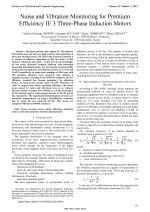| 3/2015 - 17 |
Noise and Vibration Monitoring for Premium Efficiency IE 3 Three-Phase Induction MotorsNISTOR, C. G. |
| Extra paper information in |
| Click to see author's profile in |
| Download PDF |
Author keywords
acoustic noise, energy efficiency, induction motors, noise measurement, vibration measurement
References keywords
induction(21), noise(16), machines(16), motor(15), vibration(11), phase(9), optimization(9), motors(8), drives(8), power(7)
Blue keywords are present in both the references section and the paper title.
About this article
Date of Publication: 2015-08-31
Volume 15, Issue 3, Year 2015, On page(s): 117 - 122
ISSN: 1582-7445, e-ISSN: 1844-7600
Digital Object Identifier: 10.4316/AECE.2015.03017
Web of Science Accession Number: 000360171500017
SCOPUS ID: 84940752492
Abstract
The paper presents the original SV-100 platform that enables low-cost and very high accuracy determinations of noise and vibration levels. The aim of the proposed platform is to achieve an effective integration of the two topics of this analysis: vibrations and noises. To the best of our knowledge, no low price, dedicated compact platform with embedded measuring instruments exists. For proving the practical utility of the proposed platform, two induction motors of 7.5 kW and 11 kW, respectively, in single-layer winding, at 1000 rpm, with IE3 premium efficiency were analyzed. This analysis is required because, according to IEC60034-30 standard, the IE3 efficiency standard has become mandatory for induction motors of rated power greater than 7.5 kW. Therefore, in order to improve the motor operating efficiency, the power losses caused by noises and vibrations have to be reduced. Several variants of supply were studied, i.e., by the three-phase 50 Hz network and by a three-phase inverter at 40, 50 and 60 Hz, respectively. The experimental determinations of noises are presented comparatively, by using a Bruel&Kjaer sonometer and by using the new platform SV-100. The results are compared with the IEC60034 standard. |
| References | | | Cited By |
Web of Science® Times Cited: 4 [View]
View record in Web of Science® [View]
View Related Records® [View]
Updated 2 weeks, 4 days ago
SCOPUS® Times Cited: 4
View record in SCOPUS® [Free preview]
View citations in SCOPUS® [Free preview]
[1] Vibro-acoustic simulation approach for single phase permanent split capacitor motor noise, Ionescu, Razvan-Mihai, Husar, Calin, Martinescu, Mugur, Prodan, Iulia-Maria, 2017 International Conference on Optimization of Electrical and Electronic Equipment (OPTIM) & 2017 Intl Aegean Conference on Electrical Machines and Power Electronics (ACEMP), ISBN 978-1-5090-4489-4, 2017.
Digital Object Identifier: 10.1109/OPTIM.2017.7975023 [CrossRef]
[2] Optimization of start-up characteristics for asynchronous motors used in mining excavators, Campeanu, Aurel, Vlad, Ion, Enache, Sorin, Enache, Monica-Adela, 2017 International Conference on Optimization of Electrical and Electronic Equipment (OPTIM) & 2017 Intl Aegean Conference on Electrical Machines and Power Electronics (ACEMP), ISBN 978-1-5090-4489-4, 2017.
Digital Object Identifier: 10.1109/OPTIM.2017.7975016 [CrossRef]
[3] Torque ripple calculation of two-phase IM supplied by three-leg VSI with PWM output voltage control, Zaskalicky, Pavel, 2017 International Symposium on Power Electronics (Ee), ISBN 978-1-5386-3502-5, 2017.
Digital Object Identifier: 10.1109/PEE.2017.8171679 [CrossRef]
[4] Electromagnetic torque ripple calculation of an IM under non-harmonic supply, Zaskalicky, Pavel, 2017 International Conference on Optimization of Electrical and Electronic Equipment (OPTIM) & 2017 Intl Aegean Conference on Electrical Machines and Power Electronics (ACEMP), ISBN 978-1-5090-4489-4, 2017.
Digital Object Identifier: 10.1109/OPTIM.2017.7975000 [CrossRef]
Disclaimer: All information displayed above was retrieved by using remote connections to respective databases. For the best user experience, we update all data by using background processes, and use caches in order to reduce the load on the servers we retrieve the information from. As we have no control on the availability of the database servers and sometimes the Internet connectivity may be affected, we do not guarantee the information is correct or complete. For the most accurate data, please always consult the database sites directly. Some external links require authentication or an institutional subscription.
Web of Science® is a registered trademark of Clarivate Analytics, Scopus® is a registered trademark of Elsevier B.V., other product names, company names, brand names, trademarks and logos are the property of their respective owners.
Faculty of Electrical Engineering and Computer Science
Stefan cel Mare University of Suceava, Romania
All rights reserved: Advances in Electrical and Computer Engineering is a registered trademark of the Stefan cel Mare University of Suceava. No part of this publication may be reproduced, stored in a retrieval system, photocopied, recorded or archived, without the written permission from the Editor. When authors submit their papers for publication, they agree that the copyright for their article be transferred to the Faculty of Electrical Engineering and Computer Science, Stefan cel Mare University of Suceava, Romania, if and only if the articles are accepted for publication. The copyright covers the exclusive rights to reproduce and distribute the article, including reprints and translations.
Permission for other use: The copyright owner's consent does not extend to copying for general distribution, for promotion, for creating new works, or for resale. Specific written permission must be obtained from the Editor for such copying. Direct linking to files hosted on this website is strictly prohibited.
Disclaimer: Whilst every effort is made by the publishers and editorial board to see that no inaccurate or misleading data, opinions or statements appear in this journal, they wish to make it clear that all information and opinions formulated in the articles, as well as linguistic accuracy, are the sole responsibility of the author.



